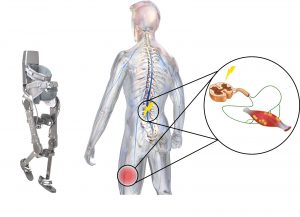
Affecting between 1.5 to 3 in every 1000 children, cerebral palsy (CP) describes a group of movement and posture disorders, in which spasticity, lack of motor coordination and muscle coactivation may describe the main characteristics observed in CP. Although technologies such as functional electrical stimulation and robot-assist gait trainer demonstrate similar effects on locomotor activity in children with CP, little is explored at the level of body function/structure and user participation, fundamental factors in locomotion ability, and rehabilitation.
At TNE and REHAssist, we aim to combine transcutaneous spinal cord stimulation and lower limbs exoskeletons for posture and gait rehabilitation in children with cerebral palsy. This approach may promote better motor and neurological rehabilitation, greater motor control during gait, and better connectivity between the supraspinal and spinal tracts can be achieved with this technique for children with CP.
Contact
If you are interested in this research topic and wish to learn more, don’t hesitate to contact us:
Mouhamed Zorkot (mouhamed.zorkot@epfl.ch)